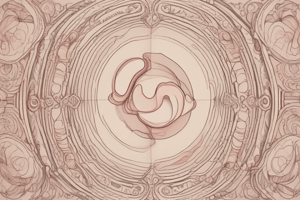Podcast
Questions and Answers
Where does the embryo implant and develop?
Where does the embryo implant and develop?
- Fallopian tube
- Ovary
- Cervix
- Uterine wall (correct)
When is the uterine wall most receptive to implantation?
When is the uterine wall most receptive to implantation?
- Immediately after menstruation
- During menstruation
- Immediately before ovulation
- 6-7 days after ovulation (correct)
The uterine cycle changes occur due to changes in the levels of which hormones?
The uterine cycle changes occur due to changes in the levels of which hormones?
- Growth hormones
- Thyroid hormones
- Adrenal hormones
- Ovarian hormones (correct)
What is shed during the menstrual phase of the uterine cycle?
What is shed during the menstrual phase of the uterine cycle?
Which phase involves the rebuilding of the functional layer of the endometrium?
Which phase involves the rebuilding of the functional layer of the endometrium?
Which phase of the uterine cycle begins immediately after ovulation?
Which phase of the uterine cycle begins immediately after ovulation?
What happens to ovarian hormone levels during the menstrual phase (days 0-4)?
What happens to ovarian hormone levels during the menstrual phase (days 0-4)?
What happens to cervical mucus during the proliferative phase?
What happens to cervical mucus during the proliferative phase?
What occurs at the end of the proliferative phase?
What occurs at the end of the proliferative phase?
During the secretory phase, endometrial glands do what?
During the secretory phase, endometrial glands do what?
What forms during the secretory phase that blocks the entry of more sperm, pathogens, and debris?
What forms during the secretory phase that blocks the entry of more sperm, pathogens, and debris?
What happens to the corpus luteum if fertilization does not occur?
What happens to the corpus luteum if fertilization does not occur?
Which hormone promotes oogenesis and follicle growth in ovaries?
Which hormone promotes oogenesis and follicle growth in ovaries?
What kind of effects does estrogen exhibit on the female reproductive tract?
What kind of effects does estrogen exhibit on the female reproductive tract?
What is promoted by estrogen relating to bone growth causing the end of bone elongation?
What is promoted by estrogen relating to bone growth causing the end of bone elongation?
Progesterone works with estrogen to do what?
Progesterone works with estrogen to do what?
During pregnancy, progesterone promotes changes in what?
During pregnancy, progesterone promotes changes in what?
What is the main source of progesterone during pregnancy?
What is the main source of progesterone during pregnancy?
What occurs in the clitoris, vaginal mucosa, and breasts due to sexual stimulation?
What occurs in the clitoris, vaginal mucosa, and breasts due to sexual stimulation?
Females can experience multiple orgasms because they have what?
Females can experience multiple orgasms because they have what?
Flashcards
Uterine Cycle
Uterine Cycle
A process in which the uterine wall prepares monthly for possible embryo implantation, influenced by ovarian hormone changes.
Menstrual Phase
Menstrual Phase
The functional layer of the endometrium is shed.
Proliferative Phase
Proliferative Phase
The functional layer of the endometrium is rebuilt.
Secretory Phase
Secretory Phase
Signup and view all the flashcards
Menstrual Phase (Days 0-4)
Menstrual Phase (Days 0-4)
Signup and view all the flashcards
Functional Layer Shedding
Functional Layer Shedding
Signup and view all the flashcards
Proliferative Phase (Days 6-14)
Proliferative Phase (Days 6-14)
Signup and view all the flashcards
Rising Estrogen
Rising Estrogen
Signup and view all the flashcards
Ovulation
Ovulation
Signup and view all the flashcards
Secretory Phase (Days 15-28)
Secretory Phase (Days 15-28)
Signup and view all the flashcards
The Secretory Phase
The Secretory Phase
Signup and view all the flashcards
Cervical Mucus Plug
Cervical Mucus Plug
Signup and view all the flashcards
No Fertilization
No Fertilization
Signup and view all the flashcards
Estrogen & Progesterone
Estrogen & Progesterone
Signup and view all the flashcards
Anabolic Effects of Estrogen
Anabolic Effects of Estrogen
Signup and view all the flashcards
Fat Deposition with Estrogen
Fat Deposition with Estrogen
Signup and view all the flashcards
Progesterone
Progesterone
Signup and view all the flashcards
Placenta
Placenta
Signup and view all the flashcards
Female Sexual Response
Female Sexual Response
Signup and view all the flashcards
Orgasm
Orgasm
Signup and view all the flashcards
Study Notes
Uterine Cycle
- Occurs in the uterine wall where the embryo implants and develops.
- The uterine wall is receptive to implantation for about 6-7 days post ovulation.
- The uterine cycle is the monthly set of changes to the endometrium to prepare for potential embryo implantation.
- The process occurs in response to ovarian hormone levels.
Regulation of the Uterine Cycle
- The uterine cycle consists of three phases: menstrual, proliferative, and secretory.
- The menstrual phase sheds the functional layer of the endometrium.
- The proliferative phase rebuilds the functional layer of the endometrium.
- The secretory phase begins immediately after ovulation.
- Enrichment of blood supply and glandular secretion of nutrients prepares the endometrium to receive an embryo.
- Both the menstrual and proliferative phases occur prior to ovulation and correspond to the follicular phase of the ovarian cycle.
- The secretory phase lines up in time with the luteal phase of the ovarian cycle.
Days 0-4: Menstrual Phase
- Ovarian hormone levels are at their lowest.
- Gonadotropin levels begin to increase.
- The functional layer of the endometrium detaches and sheds..
- Menstrual flow lasts approximately 3-5 days.
- By day 5, growing ovarian follicles produce more estrogen.
Days 6-14: Proliferative (Preovulatory) Phase:
- Rising estrogen levels lead to the creation of a new functional layer.
- Estrogen increases the synthesis of progesterone receptors in the endometrium
- Cervical mucus thins out to facilitate sperm passage
- Ovulation happens at the end of this phase, around day 14.
Days 15-28: Secretory (Postovulatory) Phase
- This phase represents the most consistent phase in duration.
- The endometrium prepares for embryo implantation.
- Rising progesterone levels from the corpus luteum cause the functional layer to become a secretory mucosa
- Endometrial glands enlarge and secrete nutrients into the uterine cavity.
- A thickened mucus forms a cervical mucus plug that blocks sperm, pathogens, and debris from entering.
Days 15-28 (Continued)
- If fertilization does not occur, the corpus luteum degenerates, and progesterone levels decline.
- Endometrial cells die, and the functional layer sloughs off.
- The uterine cycle restarts on the first day of menstruation.
Effects of Estrogen and Progesterone
-
They are female sex hormones, analogous to testosterone in males.
-
Rising estrogen levels at puberty:
- Promote oogenesis and follicle growth in ovaries.
- Exhibit anabolic effects on the female reproductive tract.
- Support the growth spurt in puberty for girls (between ages 11 and 12).
- Promote secondary sex characteristics.
- Spur Breast development and the deposition of subcutaneous fat, especially around hips and breasts.
- Lead to the development of a lighter and wider pelvis.
-
Progesterone works with estrogen to Regulate the menstrual cycle and promote changes in cervical mucus.
-
During pregnancy, it inhibits uterine motility and helps prepare the breast for lactation.
-
The placenta is the main source of progesterone, and estrogen during pregnancy, not the ovaries.
Female Sexual Response
- Initiated by touch and psychological stimuli.
- The clitoris, vaginal mucosa, bulbs of vestibule, and breasts engorge with blood; nipples become erect.
- Cervical and vestibular gland secretions lubricate the vestibule.
- Orgasm entails muscle tension, an increased pulse and blood pressure, and rhythmic contractions of the uterus, triggered by sympathetic stimulation.
- Females have no refractory period after orgasm and can experience multiple orgasms during a single sexual experience.
- Orgasm is not required for conception.
- Female libido is enabled by dehydroepiandrosterone (DHEA), an androgen produced by the adrenal cortex.
Studying That Suits You
Use AI to generate personalized quizzes and flashcards to suit your learning preferences.




